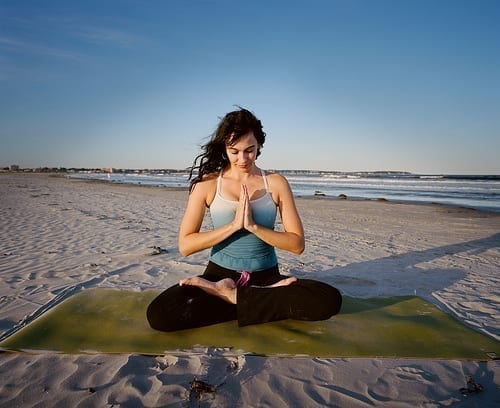Beside nutrition, healthy mind and exercise, yoga breathing may have an important role to achieve ultimate well-being.
The ancient breathing Pranayama is an efficient way to purify your body, stimulate your metabolism and get rid of the excess weight. Learning ways to calm or invigorate the body through breathing will greatly benefit your life.
Breathing is an involuntary act; it is an essential part of life. Although we cannot control whether or not we breathe, we can control the way that we breathe. A belief that different methods of breath affect the body’s health and life force is the core of Pranayama practice.
Easy Breath
Before each meal, take three deep breaths. Inhale through nose and exhale through mouth. Regardless of the simplicity it is an effective way to sharpen your palate and nose, and bring clarity to your mind. Our digestion improves and the risk to over-eat diminishes if our senses are alert during the meal. As a result we assimilate food better and over time our weight balances.
Taking one extra step – while you breathe think about how you want to feel after the meal. Be conscious of your tummy; try to feel which food would be the best to you at this moment.
Relaxing Breath
Lay down on your back, curve your knees touching your bottom with heels. Put your palms beside your navel. Take 20 slow and deep breaths. As there are many nerves in the navel area relaxing the same area calms your emotions, strengthens the nervous system and immune system helping to get rid of toxins as well as unnecessary thoughts.
Bhastrika or “Bellows Breath”
If you feel sluggish, doing a set of bhastrika breaths will clear the clouds from your body and mind. If you are trying to lose weight, doing a few rounds throughout the day will increase your digestive power and help increase your metabolism. Performing bellows breathing close to bedtime isn’t recommended, however, as it may invigorate your mind and make it difficult to fall asleep.
Begin by relaxing your shoulders and take a few deep, full breaths from your abdomen. Now start exhaling forcefully through your nose, followed by forceful, deep inhalations at the rate of one second per cycle. Your breathing is entirely from your diaphragm, keeping your head, neck, shoulders, and chest relatively still while your belly moves in and out.
Start by doing a round of ten bhastrika breaths, then breathe naturally and notice the sensations in your body. After 15 to 30 seconds, begin the next round with 20 breaths. Finally, after pausing for another 30 seconds, complete a third round of 30 breaths. If you feel light-headed or very uncomfortable, stop for a few moments before resuming in a less intense manner.
Do not practice bhastrika if you are pregnant, have menstruation, uncontrolled hypertension, epilepsy/seizures, or panic disorder. It is also recommended that you don’t practice bellows breath on a full stomach – wait at least two hours after eating.
Ujjayi Breath or Calming Breath
Ujjayi (pronounced oo-jai) is an ancient yogic breathing technique that helps calm the mind and body. Commonly translated as “victorious breath,” Ujjayi has a balancing influence on the entire cardio respiratory system and releases feelings of irritation and frustration.
Here is how to perform Ujjayi breath:
- Take an inhalation that is slightly deeper than normal. With your mouth closed, exhale through your nose while constricting your throat muscles. If you are doing this correctly, you should sound like Darth Vader from Star Wars.
- Another way to get the hang of this practice is to try exhaling the sound “haaaaah” with your mouth open. Now make a similar sound with your mouth closed, feeling the outflow of air through your nasal passages. Once you have mastered this on the outflow, use the same method for the inflow breath, gently constricting your throat as you inhale.
Try shifting into Ujjayi breath whenever you find yourself becoming aggravated or stressed, and you should notice a prompt soothing effect. If you practice yoga, focusing on Ujjayi breathing will help you stay focused and centred as you flow from one posture to the next.
Finally, Ujjayi is also useful when you’re doing aerobic exercise such as running or cycling. In fact, some Olympic-level athletes have introduced Ujjayi into their training routines to improve their respiratory efficiency. Experiment with this breath technique when you are working out and see if it reduces wear and tear on your body.
Do’s and Dont’s of Pranayama breathing
- Do not practice bhastrika if you are pregnant, have menstruation, uncontrolled hypertension, epilepsy/seizures, heart didease, hernia, or panic disorder.
- Children who are below the age of 16 should not be taught pranayama.
- Do not practice pranayama in a hurry or when the chest is congested.
- Do not practice pranayama for the day if the chest feels heavy and tense or if the sound of the breath becomes harsh and rough.
- Do not perform pranayama immediately after a meal or when you are hungry.
- Do not practice pranayama when you are depressed.
- If you have any chronic medical condition, seek advice of your doctor and yoga teacher before starting pranayama.
- Always breathe through the nose unless specifically asked to do differently.
- Pranayama should not be practiced immediately after meals. You can do pranayama at least three hours after meals. Remember a heavy meal will take much longer to get digested. For example if you do pranayama in evening, eat a healthy lunch which gets digested by the time you start pranayama.
- Do pranayama outdoors or in a well ventilated room.
Faulty practice, instead of benefiting, is more likely to invite disease. Irritability, restlessness and heaviness indicate incorrect practice and, if these happen, stop and seek the guidance of an experienced teacher.
Happy breathing!
Sources:
http://yoga.about.com
http://www.chopra.com
http://www.telegram.ee
http://www.yogawiz.com
http://www.lifepositive.com
http://www.yoga-for-beginners-a-practical-guide.com
Photo: http://www.yogadivinity.com
This post is also available in: Estonian











